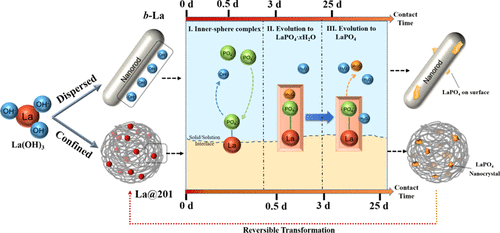当前位置:
X-MOL 学术
›
Environ. Sci. Technol.
›
论文详情
Our official English website, www.x-mol.net, welcomes your
feedback! (Note: you will need to create a separate account there.)
Structural Evolution of Lanthanum Hydroxides during Long-Term Phosphate Mitigation: Effect of Nanoconfinement
Environmental Science & Technology ( IF 10.8 ) Pub Date : 2020-12-21 , DOI: 10.1021/acs.est.0c05577 Yanyang Zhang 1 , Minglu Wang 1 , Xiang Gao 1 , Jieshu Qian 1, 2 , Bingcai Pan 1
Environmental Science & Technology ( IF 10.8 ) Pub Date : 2020-12-21 , DOI: 10.1021/acs.est.0c05577 Yanyang Zhang 1 , Minglu Wang 1 , Xiang Gao 1 , Jieshu Qian 1, 2 , Bingcai Pan 1
Affiliation

|
Lanthanum (La)-based materials are effective in removing phosphate (P) from water to prevent eutrophication. Compared to their bulky analogues, La(OH)3 nanoparticles exhibit a higher P removal efficiency and a more stable P removal ability when spatially confined inside the host. Consequently, the understanding of the nanoconfinement effects on the long-term evolution of La–P structures is crucial for their practical use in P sequestration and recycle, which, however, is still missing. Here, we describe an attempt to explore the evolution of La–P structures, the P environment, and the status of La(OH)3 nanoparticles confined in the nanopores of the D201 resin, compared to a nonconfined analogue, over a P adsorption period of 25 days in both simulated wastewater and the real bioeffluent. A combinative use of X-ray diffraction (XRD), cross-polarization nuclear magnetic resonance (CP-NMR), and X-ray photoelectron spectroscopy (XPS) techniques confirms the transition from La–P inner-sphere complexation to the formation of LaPO4·xH2O and finally to LaPO4 in both samples. Interestingly, the rate of structural transformation in the real bioeffluent is substantially reduced. Nevertheless, in both conditions, nanoconfinement results in a much faster rate and larger extent of the structural transition. Moreover, nanoconfinement also facilitates the reverse transformation of stable LaPO4 back to La(OH)3. Our work provides the scientific basis of nanoconfinement for the preferable use of La-based nanocomposites in P mitigation, immobilization, and recycle application.
中文翻译:

长期减少磷酸盐过程中氢氧化镧的结构演变:纳米约束的影响
镧(La)基材料可有效去除水中的磷酸盐(P),防止富营养化。与其庞大的类似物相比,La(OH)3纳米粒子在空间上局限于宿主内部时,具有更高的P去除效率和更稳定的P去除能力。因此,了解纳米约束对La-P结构的长期演变的影响对于它们在P螯合和循环中的实际应用至关重要,然而,这仍然是缺失的。在这里,我们描述了尝试探索La–P结构,P环境和La(OH)3的状态的尝试与无限制类似物相比,在模拟废水和实际生物废水中,P吸附时间为25天,与无限制类似物相比,纳米颗粒被限制在D201树脂的纳米孔中。X射线衍射(XRD),交叉极化核磁共振(CP-NMR)和X射线光电子能谱(XPS)技术的组合使用证实了从La-P内球络合到LaPO形成的转变4 · x H 2 O,最后到LaPO 4在两个样本中。有趣的是,实际生物废水中的结构转化率大大降低。然而,在两种情况下,纳米限制都会导致更快的速率和更大程度的结构转变。此外,纳米约束还有助于将稳定的LaPO 4反向转化回La(OH)3。我们的工作为La基纳米复合材料在P缓解,固定化和循环利用中的优选使用提供了纳米约束的科学基础。
更新日期:2021-01-05
中文翻译:

长期减少磷酸盐过程中氢氧化镧的结构演变:纳米约束的影响
镧(La)基材料可有效去除水中的磷酸盐(P),防止富营养化。与其庞大的类似物相比,La(OH)3纳米粒子在空间上局限于宿主内部时,具有更高的P去除效率和更稳定的P去除能力。因此,了解纳米约束对La-P结构的长期演变的影响对于它们在P螯合和循环中的实际应用至关重要,然而,这仍然是缺失的。在这里,我们描述了尝试探索La–P结构,P环境和La(OH)3的状态的尝试与无限制类似物相比,在模拟废水和实际生物废水中,P吸附时间为25天,与无限制类似物相比,纳米颗粒被限制在D201树脂的纳米孔中。X射线衍射(XRD),交叉极化核磁共振(CP-NMR)和X射线光电子能谱(XPS)技术的组合使用证实了从La-P内球络合到LaPO形成的转变4 · x H 2 O,最后到LaPO 4在两个样本中。有趣的是,实际生物废水中的结构转化率大大降低。然而,在两种情况下,纳米限制都会导致更快的速率和更大程度的结构转变。此外,纳米约束还有助于将稳定的LaPO 4反向转化回La(OH)3。我们的工作为La基纳米复合材料在P缓解,固定化和循环利用中的优选使用提供了纳米约束的科学基础。













































 京公网安备 11010802027423号
京公网安备 11010802027423号